In enterprise social media, the stakes can be high. (As can the number of stakeholders.)
Social media is now a critical marketing and communication tool for companies of all sizes. But managing enterprise social media isn’t the same as running social for a small business.
Like anywhere else, an enterprise’s social strategy must drive results that contribute to the organization’s overall goals. But in a larger company, you must also align with more people and policies than you would at a smaller company. You often have to juggle efficiency and compliance demands with driving real business results.
Let’s review how an enterprise social platform can help streamline teamwork and ensure you hit your business goals.
Managing social media for a big company isn’t a one-person job. It involves input and approvals from various teams across your organization.
Want to execute your social strategy and manage everything efficiently? You need the right tools to standardize processes, protect your brand and save employees’ time.
Here are seven elements of the best enterprise social media solutions for large organizations.
1. Business priorities
In large companies, day-to-day social media management can feel far from conversations in the boardroom.
To use social media effectively, you need a solid social media strategy. And to create a solid social strategy, you need to understand what matters most to the success of the business right now.
What are the current business priorities at your company? What problems is the business trying to solve? If you know the answers to those questions, you can build SMART goals to guide your social efforts.
If you don’t know the answers, ask. A quick 15-minute meeting with the head of social marketing and the CMO can quickly align priorities.
2. Compliance and security
Organizations in regulated industries are well-versed in managing compliance requirements. But all enterprise-level organizations (and social team members) need to understand how advertising and consumer protection regulations affect their use of social media.
Compliance risks exist, but they can be managed if you have a plan and use the right social media tools to protect your brand.
We’ve got a whole blog post on how to stay compliant on social media, but here are a few key things to keep in mind:
- Stay on top of privacy, data security, and confidentiality requirements. These could affect how you store or share information and photos.
- Be sure to disclose sponsorships, influencer relationships, and other marketing agreements.
- Make sure you control access to your social accounts and have a social media policy in place.
If you’re on the social team and aren’t sure what your organization’s compliance policies are, touch base with the legal team. It’s better to ask questions than to put your company at risk with a seemingly harmless (but non-compliant) social post.
3. Crisis communications
Most large companies have to deal with a crisis at some point. (After all, 100% of all companies had to navigate a global pandemic not too long ago).
When it comes to crisis communications, your social channels are the fastest way to disseminate information. The real-time nature of social provides the agility to adapt quickly to changing conditions. But only if you have an appropriate plan and guidelines in place.
Make sure there’s a crisis communications plan in place — and that people know about it. Everyone who touches a company’s social media process should know the plan in case they need to act on it.
Your public social networks are also an easy channel for customers to interact directly with your team. This inevitably leads to comment sections and DMs being filled with feedback or queries — which, at times, may be negative.
Have a plan, so teams know how to respond and when to escalate. This is especially important if you have a dedicated customer service team for social. Your customer service team should be trained and prepared to manage all types of queries or responses.
You may also need to deal with a public relations crisis specific to your brand. Your company’s social platforms will play a role in brand messaging associated with a PR crisis. A crisis communication plan ensures you use social channels to make the situation better, not worse.
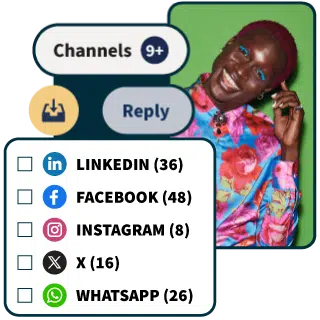
Manage all your messages stress-free with easy routing, saved replies, and friendly chatbots. Try Hootsuite’s Inbox today.
Book a Demo4. Analytics and reporting
Within the social team, it’s fine to get excited by victories tied to vanity metrics like likes and comments.
But stakeholders higher up in an enterprise organization need to see real business results. Otherwise, it’s hard for them to fully buy into your social strategy and grant the necessary approvals.
That’s why it’s important to communicate the impact of your social media efforts. An analytics tool can help you track the metrics your team has already determined are most important for your business.
When reporting your results, focus on quantifiable progress toward your goals. It’s even better if you can frame your results in real dollars and cents. Demonstrate the ROI of your social efforts, or show how social fills your sales funnel or drives purchase intent.
5. Approval process
Your social team should already be well-versed in the company’s social media compliance policies. But there still needs to be an approval process in place.
A clear process ensures that the social team isn’t publishing anything that isn’t compliant or secure. It also means that your pipeline of content ideas isn’t getting delayed by the legal team.
Choose an enterprise social software that helps establish an approval workflow. The process should make it easy for the social team to share content with legal to review on time.
6. Social listening
Staying on top of all direct or indirect brand mentions can be tricky if you’re covering multiple social channels. An enterprise social tool with social listening capabilities is key to staying tapped into online conversations.
Social listening helps you conduct audience research, sentiment analysis, and even competitor research.
It also goes hand in hand with crisis communications. Staying tapped into what people are saying on social media about your company or industry is essential for any enterprise.
Being aware of any negative feedback on your brand can help your team act quickly and respond as necessary.
7. Employee advocacy
Do you have an employee advocacy program at your company? An engaged workforce can share their positive experiences or promote company initiatives.
Employee advocacy is a great way to build brand trust. It will also boost your reputation among potential employees and customers alike.
But at a large enterprise, it can be challenging to keep tabs on everything your employees share without a social media advocacy program in place.
Whether your workforce is promoting a product launch or sharing a job posting, there needs to be a procedure in place. After you provide guidance on brand messaging and social sharing, use your enterprise social platform to track the ROI of employee advocacy initiatives.
6 top tools to include in your enterprise marketing toolkit
Running social at the enterprise level involves various moving parts across your organization. To manage everything efficiently, you need the right tools to standardize processes, protect your brand, and save employees’ time.
Here are 6 of the best enterprise social media solutions to maximize social benefits for large organizations.
Enterprise social media management: Hootsuite
There’s a reason why Hootsuite is used by employees at more than 800 of the Fortune 1000 enterprises.
Hootsuite is a critical social tool for businesses of all sizes. It allows teams to manage multiple enterprise social media platforms from one dashboard.
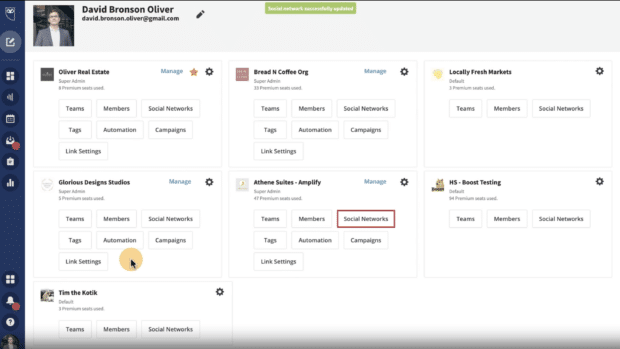
Source: Hootsuite
Its built-in teamwork and approval tools streamline task management, project management, and employee collaboration.
For enterprise customers, Hootsuite’s advanced features help you integrate other business centers with your social tools.
Employee advocacy: Hootsuite Amplify
Amplify is an intuitive app that makes employee content sharing easy — and safe. Your workforce can use it to share approved social content with their own friends and followers on the fly.
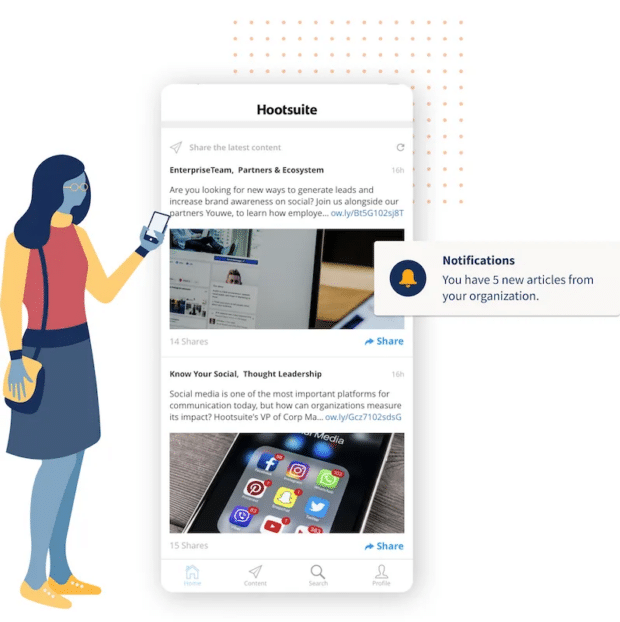
As part of a complete employee advocacy solution, Amplify also helps boost employee engagement. Your people can easily stay connected and informed about what’s happening in your organization.
Analytics: Hootsuite Advanced Analytics
Hootsuite Advanced provides enterprise-level customers with advanced social analytics. You can track organic and paid campaigns side-by-side. This data allows you to measure and analyze your social marketing efforts while improving ROI.
Built-in visual tools like graphs and charts allow you to create custom reports for various stakeholder groups.

Everyone gets exactly the information they need, presented in a way that’s easy to understand.
Research: Hootsuite Listening (powered by Talkwalker)
Hootsuite Listening (powered by Talkwalker) is an Enterprise plan add-on designed for businesses that want to build an even more effective social strategy based on real data.

Built-in sentiment analysis tools also let you know how people feel when they talk about your brand or your products on social channels. After all, measuring social impact is about more than volume.
Digital advertising: Hootsuite Social Advertising
Hootsuite Social Advertising allows your teams to manage paid *and* organic social posts across multiple channels — all from one dashboard.
With Hootsuite’s ad tool, you can use detailed insights to optimize your social goals at every stage of the customer journey.
Your team can also analyze performance metrics from individual ads, ad campaigns, and organic posts so you can create a comprehensive report for stakeholders higher up in your organization.

Customer service: Hootsuite Inbox
Social media is no longer an optional channel for customer service. You have to integrate your customer service and care with your enterprise social platform to meet customers where they are.
With Hootsuite Inbox, you can bridge the gap between social media engagement and customer service — and manage all of your social media messages in one place. This includes:
- Private messages and DMs
- Public messages and posts on your profiles
- Dark and organic comments
- Mentions
- Emoji reactions
… and more.
The all-in-one agent workspace makes it easy to
- Track the history of any individual’s interactions with your brand on social media (across your accounts and platforms), giving your team the context needed to personalize replies
- Add notes to customers’ profiles (Inbox integrates with Salesforce and Microsoft Dynamics)
- Handle messages as a team, with intuitive message queues, task assignments, statuses, and filters
- Track response times and CSAT metrics

Plus, Inbox comes with handy automations:
- Automated message routing
- Auto-responses and saved replies
- Automatically triggered customer satisfaction surveys
- AI-powered chatbot features
Enterprise marketing automation: Adobe Marketo Engage
Many enterprise marketers already use Adobe Marketo Engage for marketing automation. Integrating social data takes Marketo to the next level.
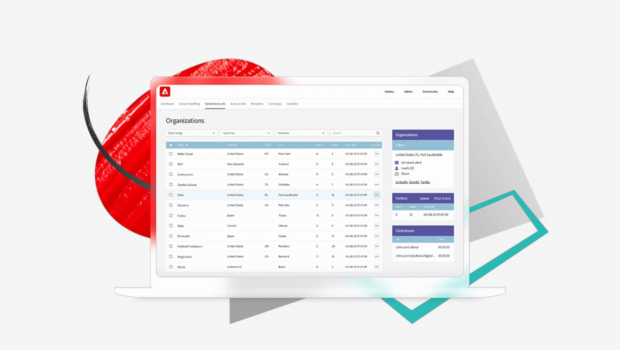
Source: Marketo
You can add social channels to your lead-scoring platforms using the Marketo Enterprise Integration app for Hootsuite. Then, you can target leads with the right messages for where they are in the customer journey.
You can also see lead details right in a Hootsuite stream. This makes it easy to drive more leads to your sales funnel by adding details of their social activity.
Enterprise CRM: Salesforce
Organizations of all sizes can benefit from connecting their social data with their enterprise CRM (customer relationship management) systems.
A social CRM is a critical way to turn social fans into real business leads with data that teams across an organization can benefit from. And Salesforce is a leader in the CRM space.
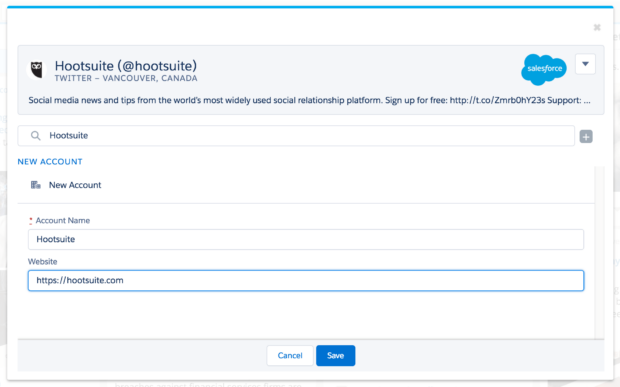
Source: Hootsuite
Salesforce can integrate with your social marketing efforts and expand customer relationship management to social channels. It’s a great resource to support social selling.
You can identify and capture new sales leads and opportunities that you discover on social into the CRM you already rely on.
The Salesforce Enterprise Integration app for Hootsuite provides details and activity history for Salesforce leads and contacts. You can add key social activities and conversations to their records. Additionally, you can manage details of Salesforce customer cases right within the Hootsuite dashboard.
Psstt: If you already use Salesforce Social Studio and are looking for a replacement, we can help!
Enterprise Compliance: Smarsh
Compliance and security are big challenges when implementing an enterprise social media strategy.
Smarsh automatically checks for corporate and regulatory compliance and security issues through an approval workflow. All content is archived and available for real-time review.
All of your social posts can also be placed on legal hold. They can be added to cases or exported in case they’re required for internal investigations or discovery.
Smarsh & Hootsuite: Compliance in the social media age
Enterprise collaboration: Slack
Slack has quickly become a favorite enterprise collaboration tool. Remote workers and distributed teams are increasingly common. Slack helps those teams get things done.
The Slack Pro app for Hootsuite makes internal team collaboration and communication easy. Employees can send social media posts directly to a specific Slack channel, user, or group right from the Hootsuite dashboard. This makes it easy to keep everyone in the loop, all in one place.
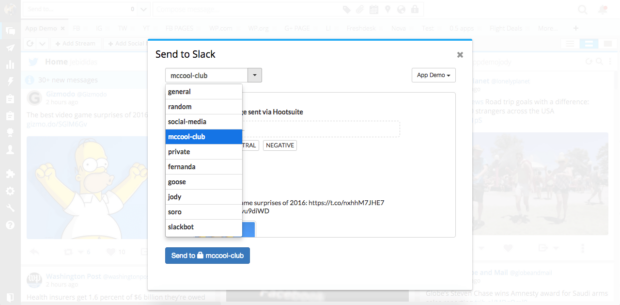
Source: Slack
You can use the Slack integration to capture relevant social information for each message. It also allows you to assign sentiment and add a comment to each post.
From smarter collaboration to stronger security, these tips and tools will help your organization save time and let your team do more — right from within your Hootsuite dashboard. Bring the power of social media to the tools that already support your enterprise.







